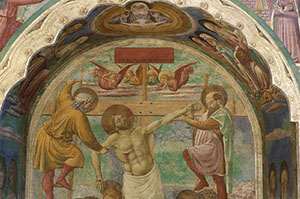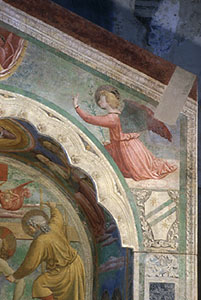
Tabernacle of the Executed, detail of the Deposition, Certaldo.

Tabernacle of the Executed, archway depicting the Annunciation, Certaldo.
From 1464 to 1465, Benozzo resided in Certaldo, a small town in the heart of the Elsa Valley, which in 1415 had become one of the three Vicariates into which the Florentine Republic was administratively divided, and whose jurisdiction extended from Valdelsa to Val di Pesa and stretches of Valdarno. Vicariate records indicate that, at that time, Certaldo was where all criminal trials were held and sentences passed on those who lived within the confines of the Vicariate. For this reason, the Vicar of Certaldo commissioned a majestic tabernacle from Benozzo which, at that time, was situated near the bridge over the river Agliena, outside the city walls, where capital punishment was traditionally carried out by beheading. The condemned were accompanied to this chapel to be comforted by the brothers of the Company of Justice, a lay institution that assisted them in their final hours, encouraging them to pray and repent. Because of this tradition, the tabernacle was known as that 'of the Executed', and it was in this context that the iconographic theme of the frescoes was chosen, namely the passion of Christ and the martyrdom of certain saints, stories taken from the Holy Scriptures that were intended to help the condemned to better endure the grim end that awaited them. The Deposition which occupied the main wall thus symbolised the culminating moment in the salvation and possible redemption for those who confessed their sins. Depicted on the external archway is the Annunciation of the Virgin, while the inner wall bears a representation of the Deposition, with Joseph of Arimathea and Nicodemus, standing on two ladders to take down the now dead Jesus from the cross. The face of Jesus shows no sign of the pain he had suffered, a detail that might offer comfort to those sentenced to death, and only the bleeding wound on his ribs symbolises his Passion. Featuring in the scene are several apostles and the Madonna accompanied by Mary Magdalene. The underside of the arch on the main facade is decorated with God the Father surrounded by the Evangelists Matthew and Mark on the right and Luke and John on the left. The walls of the extrados are decorated with the figures of Saints Longinus, John the Baptist, Jacob and Anthony. The exterior walls are painted with the Crucifixion and the Martyrdom of Saint Sebastian. The rear facade, on the other hand, was dedicated to the theme of the Resurrection, the first scene that appeared to the condemned as they were led from the Court Room at the Vicarial Palace to the 'Meadow of Justice', a small grassy area on the riverbank.
Critics are now unanimous in attributing to Benozzo the compositional structure, pictorial designs, the direction of works and the execution of certain parts, while an important role has been attributed to his studio and, in particular, to Giusto di Andrea who notes in his Diary that this was the last work he carried out at his master's side before moving to Florence where, in March 1465, he rented an artist's studio of his own. This evidence has made it possible to date the work to the first few months of that year. This hypothesis is supported by a letter sent by Benozzo to Lorenzo de' Medici on 4th July 1467, thanking him for interceding on behalf of one of the artist's co-workers (Giovanni della Cecca di Mugello, who had been accused by the Augustinians of San Gimignano of stealing some bed sheets). Indeed, this letter makes explicit reference to the work in Certaldo as having been completed some time earlier. It also provides confirmation of the fruitful relationship and the strong bond between Benozzo and the Medici family.
Certain frescoed parts of this tabernacle, too, have been lost due to damage caused by humidity and, for this reason, the paintings were detached in 1957 and moved to the former Church of Saints Thomas and Prosper, annexed to the Vicarial Palace.
Serena Nocentini